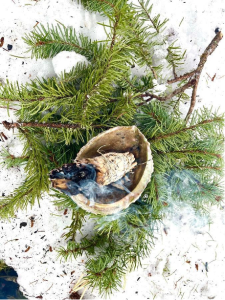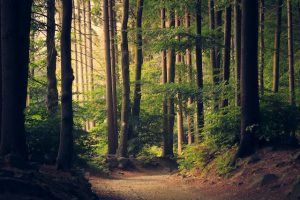Stepping Stone 5: Indigenous Concepts of Health and Wellness Part 1
by Dr. Rosalin Miles
Introduction

The diversity of Indigenous ways of knowing that spans across Turtle Island is reflected within each community. These ways of knowing embody Indigenous communities; cultural and traditional practices that may be integrated to support the best practices of health and wellness. Indigenous concepts for the spiritual, emotional, mental (intellectual) and physical components of health and wellness are based on shared intergenerational knowledge and values within families and communities. This information is typically passed down by Elders or Knowledge Keepers to community and family members (Rowe, 2020). Indigenous healing and wellness are achieved through the balance and inter-relationships of the spiritual, emotional, mental, and physical components of health and well-being, and extends beyond the individual to include family, community, and relationships with the land (Absolon, 2010; Field et al., 2022).
Wholistic Learning Objectives
Stepping Stone 5 provides learners an opportunity to reflect on diverse concepts of Indigenous Health and Wellness and ties to physical activity from a wholistic perspective. Learners will also explore the importance of being active in promoting health and wellness.
Upon completion of Stepping Stone 5, learners should be able to:
*click through all 5 slides to read each of the wholistic learning objectives*
Warm-up Activity
 It can be tempting to skip your warm-up and move quickly into thinking about health and wellness promotion that is inclusive of traditional activities. Like missing your warm-up before engaging in exercise, this may result in less than ideal outcomes. Community and family concepts must be developed together with Indigenous Knowledge Keepers, some of whom are also health professionals. It is valuable to take the strengths from Traditional and Western medicine practices to create current health and wellness concepts and practices.
It can be tempting to skip your warm-up and move quickly into thinking about health and wellness promotion that is inclusive of traditional activities. Like missing your warm-up before engaging in exercise, this may result in less than ideal outcomes. Community and family concepts must be developed together with Indigenous Knowledge Keepers, some of whom are also health professionals. It is valuable to take the strengths from Traditional and Western medicine practices to create current health and wellness concepts and practices.
- What are your thoughts of these images as they relate to health and wellness?
- Would these pictures be inclusive and fully representative of health and wellness from a wholistic approach?
Two-Eyed Seeing Approach
In Stepping Stone 5, we leap back in time to find the cultural and traditional practices over the generations, weaving them into future practices that include the Two-Eyed Seeing approach discussed in Stepping Stone 4, as well as in the activity below. Throughout this Stepping Stone, we will discuss Indigenous people’s diverse concepts of health and wellness.
Activity 1
Watch the following video: Wellness, two-eyed seeing and system change: Dr. Evan Adams at TEDxPowellRiver (17:07)
- What are the strengths of the Two-Eyed Seeing approach?
Embracing Indigenous Ways of Knowing
Conceptualizing health and wellness from a strengths-based perspective and understanding associated practices within Indigenous communities empowers and inspires individuals to reflect on their personal wholistic aspirations. This reflection also revitalizes connections from one’s past generational teachings and allows a harnessing of cultural traditions and spiritual connection to the land (Bryant et al., 2021). It is critical to health and wellness that there is balance in the four wholistic dimensions and that they are all nurtured together to create a level of health and well-being that reflects individuals’ gifts and aspirations (Acharibasam et al., 2022).
When considering concepts of Indigenous health and wellness, recognizing your own identity and the cross-sections you may have (intersectional identity) is critical. As a woman, man, Two-Spirit, or other gendered person, your own diverse and unique views of and within your family and community influence your concepts of health and wellness.
Additionally, we need to recognize a life cycle that is inclusive of maternal health and wellness from infancy to the Elderly. As family teachings and connections are the foundation for Indigenous ways of knowing for health and wellness, the impacts of Indian Residential Schools were profoundly negative on cultural continuity for Indigenous communities. Indigenous peoples’ health and wellness were dismantled by separating families and removing children from cultural ties. Thus, we are reminded of the important spiritual phrase “All Our Relations” which refers to the interconnectedness and respect that Indigenous people may have for past and future generations.
Embracing Indigenous ways of knowing and the influence of cultural and traditional ways of life may be empowering for community members to reconcile and aspire for healing and balance. Crucially, all diverse concepts of Indigenous health and wellness must be met with cultural safety within the western or colonial healthcare system. Cultural safety, importantly, recognizes Indigenous ways of knowing and includes strengths-based teachings.
Hoop Dancing
In this next part of Stepping Stone 5, we are going to explore one important physical activity that radiates connectivity to health and wellness in some Indigenous communities- hoop dancing. Hoop dancing is a traditional physical activity, and it highlights connections between wholistic health and wellness.
Activity 2
Take some time to watch the following video: Living a circular life | Dallas Arcand | TEDxYYC (17:47)
After watching “Living a Circular Life”, please reflect on and consider your answers to the following questions:
- How does Hoop dancing promote wholistic health and wellness?
- Why is it more beneficial to practice traditional activities for Indigenous people?
Indigenous Perspectives on Health
There are many Indigenous community members who believe that to have spiritual, emotional, or mental balance, you must be physically active first. However, some Indigenous community members’ concepts of health and wellness may also be based on traditional, cultural, and spiritual ties. Being physically active positively impacts spiritual, emotional, mental health and overall wellness (Ferguson et al., 2019).
Physical activity has strong ties to spiritual reverence by knowing one’s gift of the physical body. This knowing connects to the past and future seven generations, and generational spirits are reflected in your own existence. The link to the past seven generations recognizes community ties and the creation of your wholistic identity from history, familial relationships, and teachings of values and stories (Graham, 2008). The connection of the physical body, and the acknowledgment that your identity will be reflected in the next seven generations, is a part of the Indigenous way of knowing which ties to spirits before and after.
Being physically active in nature helps to promote reconnection to culture and traditions. Activity in nature can include many experiences, such as nature walks with family, harvesting food, or fishing and hunting (Bowra et al., 2020). In addition, being physically active in nature also contributes to emotional balance by promoting a reduction in anxiety and stress. Physical activity (in any form, including traditional activities, sports, recreation, or fitness) supports a myriad of benefits from both a Two-Eyed Seeing approach (Martin, 2012) and scientifically. Some of these benefits include restoration of emotional balance by releasing endorphins, promoting cardiovascular health, as well as providing more self-confidence and wellness. Mental wellness is also improved when being physically active traditionally by connecting Indigenous ways of knowing into practice. For example, when performing physical acts like walking, this empowers the person to practice meditative ways of thinking due to high repetition and low intensity. Being physically active also supports awareness of one’s body and abilities. Practicing physical activity and Indigenous ways of knowing is an important concept for self-determination.
Activity 3

Immerse yourself in nature, enjoy a walk, or engage in any kind of movement, and listen to the following podcast:
#53 Indigenous Perspectives on Health
Then, consider the following:
- What Indigenous ways of knowing were shared in this podcast?
- Why is it important to be strengths-based and not deficit-based when viewing Indigenous perspectives of health and wellness?
Exploring Wellness
Activity 4
Read the following article.
After reading the article, take a few moments to answer the following questions:
- How is wellness described?
- How does bringing Métis women together support wellness?
Inuit Perspectives on Health
Activity 5
Watch: Inuit Cultural History and The Medical System (22:06)
- What are the Inuit health and wellness perspectives?
Wellness Break

Think about our discussion of hoop dancing. Take a movement break and see how many body parts you can move in a circle (this may include your wrists, arms, fingers, ankles, legs). Think about the concept of circles in relation to the traditional hoop dance. Be aware of your body’s ability to move in circles.
Slowly move your head in 2 circles one way and then 2 circles the other way, and then rotate your shoulders up and around to the back, and up and around to the front. Appreciate the continuity of movement and connect with it.
A Deeper Journey
We encourage you to explore these additional resources for a deeper journey related to this Stepping Stone.
*click on the headings below to reveal more resources*
Stepping Stone 5 Summary
 Indigenous concepts of health and wellness are diverse but inclusive of cultural and traditional practices from past generations. The concepts of health and wellness practiced by Indigenous peoples across Turtle Island have strong ties to our history before colonization. The connection to community and family for health and wellness practices is essential to continue healing and for self-determination. The promotion of traditional physical activities within Indigenous communities has connections to emotional, spiritual, and mental health and wellness. Revitalization of traditional Indigenous concepts of health and wellness within community, combined with mainstream western health care systems, is key for the success of the Two-Eyed Seeing approach. In Stepping Stone 6, we will continue this reflection on the importance of ties to culture and traditions for mental and emotional wellness.
Indigenous concepts of health and wellness are diverse but inclusive of cultural and traditional practices from past generations. The concepts of health and wellness practiced by Indigenous peoples across Turtle Island have strong ties to our history before colonization. The connection to community and family for health and wellness practices is essential to continue healing and for self-determination. The promotion of traditional physical activities within Indigenous communities has connections to emotional, spiritual, and mental health and wellness. Revitalization of traditional Indigenous concepts of health and wellness within community, combined with mainstream western health care systems, is key for the success of the Two-Eyed Seeing approach. In Stepping Stone 6, we will continue this reflection on the importance of ties to culture and traditions for mental and emotional wellness.
Cool-down Activity
 We have learned about the importance of the connection to community as it relates to physical activity. Practicing Indigenous ways of knowing for health and well–being is very accessible and inclusive. However, each community is different and it is important to understand these concepts where you live and play.
We have learned about the importance of the connection to community as it relates to physical activity. Practicing Indigenous ways of knowing for health and well–being is very accessible and inclusive. However, each community is different and it is important to understand these concepts where you live and play.

